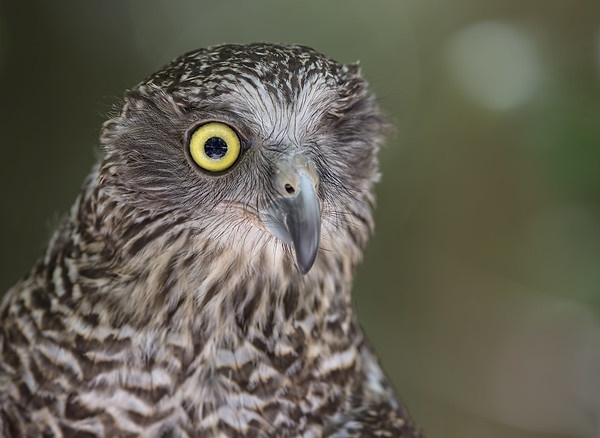Blakiston’s Fish Owl
Blakiston’s Fish Owl (Ketupa blakistoni) is the largest owl in the world – healthy females can tip the scales at a whopping 10 lbs or 4.5 kg! Besides being the largest owl in general, Blakiston’s Fish Owl also sports the widest wingspan of any extant owl species: up to 200 cm (6 ft 7 in) for the largest specimens. As their name implies, these are fishing owls, applying powerful muscles and hooked talons to haul large fish two to three times their weight out of the water. (image via Takashi Muramatsu)
* Amazing Owl Fact: Blakiston’s Fish Owl is considered to be an endangered species due to the effects of habitat loss to human activity. Their natural predators include the Eurasian Lynx and the Asiatic Black Bear, creatures that compete with these fishing owls for food resources.
Powerful Owl
As animal names go, it’s tough to beat the Powerful Owl (Ninox strenua). These large owls are native to forested areas in eastern Australia where they prey upon arboreal (tree-living) mammals including possums, gliders and koalas. In a land with few large mammalian carnivores, Powerful Owls are the top nocturnal predators in their natural woodland range. (image via Rex Boggs)
* Amazing Owl Fact: Powerful Owls are diligent and dutiful nest-keepers but males and females may have markedly different reactions to human intrusion: females may desert the nest entirely, while males have been known to attack unwary humans who come too close.
Burrowing Owl
The Burrowing Owl (Athene cunicularia) is a native of the Americas, where it ranges from southern areas of western Canada down to Tierra del Fuego in the southernmost reaches of Patagonia. As their name implies, Burrowing Owls will dig nesting and resting burrows in soft ground but they prefer to take over abandoned burrows excavated by ground squirrels and prairie dogs. They fly as well as any other owl but have long legs that allow them to sprint after prey on the ground. (image via Alexandre Marino)
* Amazing Owl Fact: Burrowing Owls and rattlesnakes tend to seek out the same types of burrows in areas where their ranges overlap. In addition, Burrowing Owls who are being pursued by predators have been known to make hissing and rattling sounds in imitation of their venomous rivals.
Red Owl
The Red Owl (Tyto soumagnei) isn’t very red… but it IS very rare. How rare, you ask? Well, consider that after its initial discovery in 1876, the species basically went AWOL until its rediscovery by a World Wide Fund for Nature research team in 1993.
With that said, the Red Owl isn’t out of the woods yet, so to speak. Their forested home range in eastern Madagascar is threatened by human activity, and their preferred food source (the Tsingy tufted-tailed rat) is also feeling the deleterious effects of habitat loss. (images via Charles Davies)
* Amazing Owl Fact: Red Owls are in the Barn Owl family (Tytonidae) and as such, display a heart-shaped face and deep black eyes. Red Owls prey on native species of rodents, however, while other owls in Madagascar prefer to hunt introduced rodent species, bats and birds.
Happily hoot & holler about night-flying creatures? Check out Bats Motel: Giant Bat Roosts Were Ahead Of Their Time!

